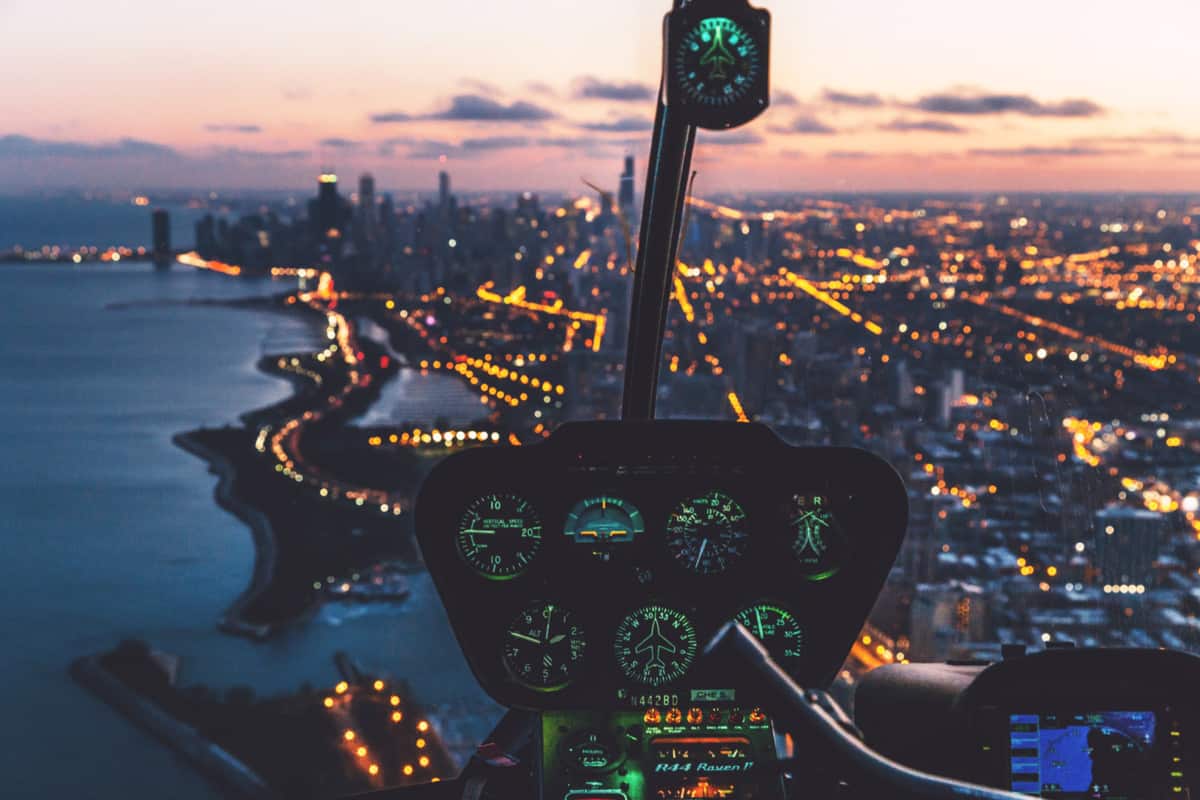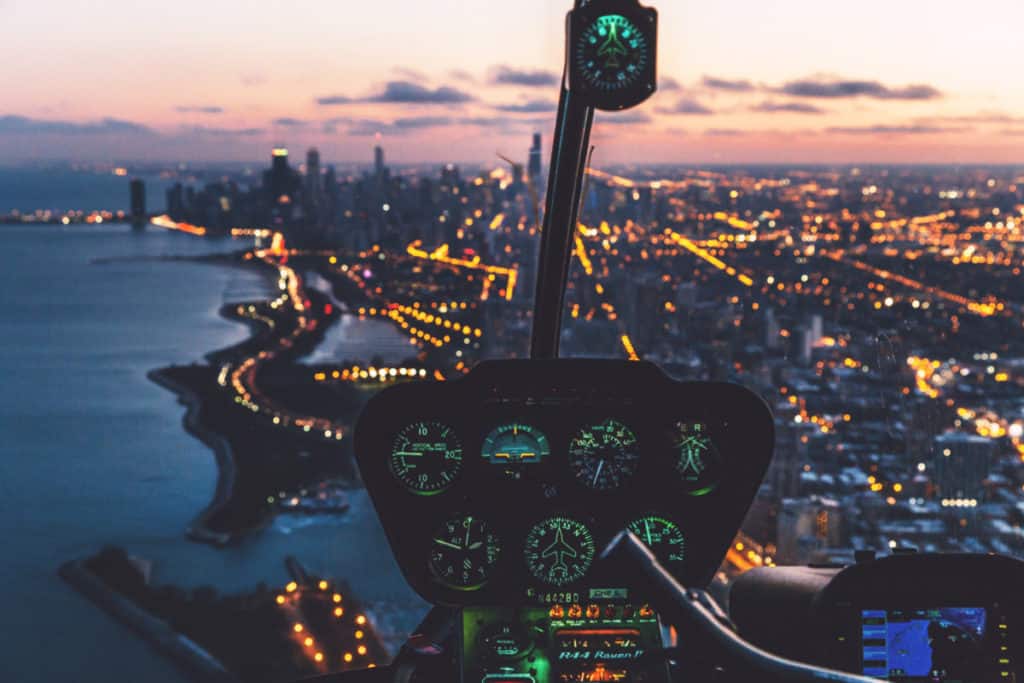
Many people hear and see police helicopters flying around their city at night but are they the only helicopters that are allowed to fly at night? Well, after spending hundreds of hours flying helicopters at night I can tell you there is a lot more to it than you may think!
Helicopters can be flown at night. Depending on the country, the pilot/s may need specific training and a night rating, some might need certain equipment and instrumentation in their helicopter and some may not be allowed to fly at all. Flying at night can be safe provided certain rules are followed.
I have flown the most basic helicopters with only one engine and very little instrumentation at night up to one of the world’s most technologically advanced helicopters with two very powerful engines and full auto-flight capabilities and both can be flown safely provided they are flown in the right conditions.
It takes good training and pilot experience to ensure the helicopter remains safe at all times so if you want to know more about flying a helicopter at night, please read on…
Why Would a Helicopter Fly at Night?
For most countries, the helicopters that regularly fly at night are mainly police, air ambulance, corporate VIP, and military. A small amount of flight training takes place as all pilots will need to gain experience with a qualified instructor before being confident enough to fly.
Why Do Police Helicopters Fly At Night?
During the night criminal activity increases dramatically in most cities because of the cover of darkness. Most police forces utilize a helicopter to track and observe using powerful cameras and searchlights that allow them to help coordinate their ground officers via radio communication.
For this reason, you may find a police helicopter circling around your house at night. They can cover a very large area of a neighborhood from 1000 feet above and circling uses a lot less fuel than hovering, it allows them to stay mobile in case the subject changes direction and it also cuts down on the noise pollution to the residents sleeping below them.
Most police helicopters will only land and take off from well-lit airports or heliports. They very rarely, if ever, land anywhere else during the hours of darkness.
If you wish to find out more about police helicopters please check out these articles:
Police Helicopters – All You Needed to Know
Why Do Air Ambulance Helicopters Fly at Night?
To ensure the fast response of medical attention is received many air ambulance helicopters will also fly at night. The helicopter really helps reduce the time it takes to reach patients in remote areas and allows for fast transfers between medical facilities.
For some patients, time is the difference between survival and fatality. Mother nature does not always concentrate on causing people harm just during daylight hours so getting medical attention 24/7 is key. Depending on the country and the local area, the capabilities of their local medevac helicopter can vary dramatically.
Some EMS helicopters may only be allowed to operate between lit airports and hospital helipads whereas, some may be able to land in the closest park or field even on the darkest nights. The more capabilities the helicopter and crew have, the more the operation will cost.
Medevac helicopters can be simple single-pilot, single-engine over-the-city-only operations or be complex, twin-engine, dual-pilot all-weather capable machines.
Why Do Private, Corporate & VIP Helicopters Fly at Night?
When the wealthy or corporations need to get personnel from A to B rapidly, then a helicopter is usually at the top of the list. A basic helicopter can easily be flown over a well-lit city with very minimal equipment onboard or pilot training. When safety, poor weather, and flights into remote areas are required, then twin-engine, all-weather-capable helicopters will be flown, usually by two pilots.
In the winter months when the sun sets early or the passengers are wanting to fly late into the evening, a helicopter can easily be used to fly them from a rooftop helipad, downtown heliport, or local airport to any appropriately prepared landing area. When VIP passengers do not like to wait, a helicopter with the right crew on board can be very lucrative to a helicopter company and in many large cities, VIP helicopters flying at night is very common.
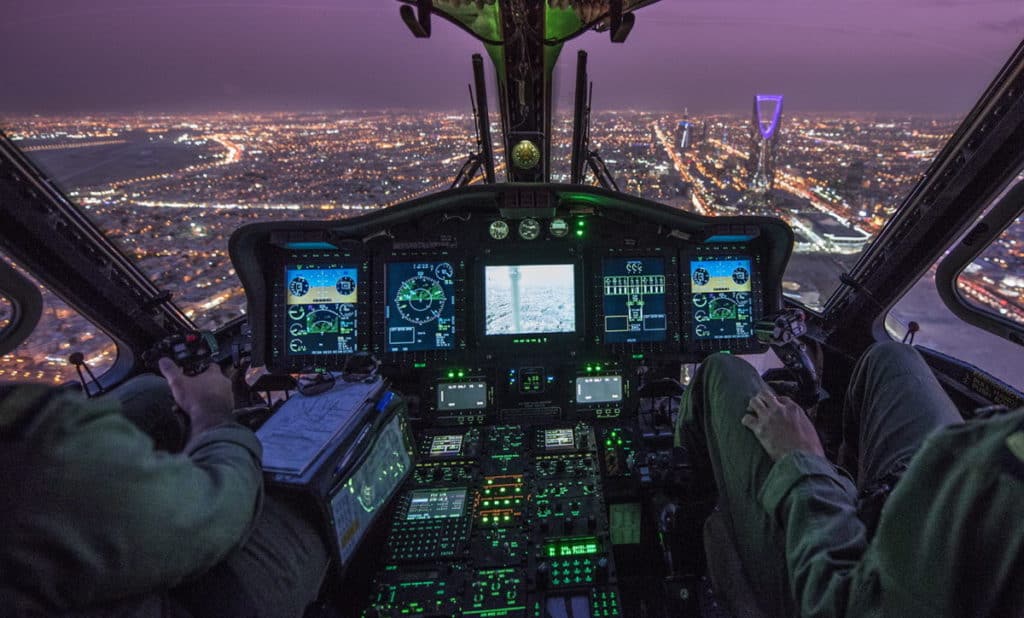
Just like any tool – Ensuring the right aircraft, with the right pilots, with the right training, are used, then the flights are eventless. When corners are cut and the wrong aircraft or pilot is used then disaster usually ensues.
Why Do Military Helicopters Fly at Night?
Military pilots need to fly in all weather and at night. Regular training is needed to allow the pilots to develop the necessary skills to fly low, fast, and undetected ready for wartime operations. Night training will usually be completed in military training areas but flights over cities can often be seen when relocated between bases and training facilities.
The art of sneaking up on the enemy is one of the military’s greatest advantages and to do this safely requires extensive training. Most military helicopters will use the latest in night-vision goggle technology, heads-up synthetic vision technology, and vast amounts of training. For some of the worlds, most technologically-advanced military forces, flying at night is not that far different from flying during the day!

Join My Newsletter & Get Great Tips, Information and Experiences To Help You Become a Superb Pilot!
Do Pilots Need Training to Fly at Night?
The aviation rules of the country in which that pilot is flying will dictate what kind of training they will need to fly the country in which the pilot is flying will dictate what kind of training they will need to fly a helicopter at night. In the U.S. pilots gain night flying experience during initial flight training. In other countries, like the UK & Canada pilots need additional training for a night rating.
In the US, every pilot will complete at least 3 hours of night flying training during their Private Pilot Certificate which allows them to fly an aircraft at night by themself. If that pilot then carries on to gain their commercial pilot certificate they will then do further night training both with an instructor and solo before they can apply for their commercial flight test.
If at any time they wish to fly passengers they must ensure they have completed 3 takeoffs and 3 landings to a full stop in the same kind of aircraft within the preceding 90 days.
In other countries like the UK and Canada, a pilot can only fly at night once they have completed a Night Rating training program. This training will include a mix of night flying and flying by sole reference to the helicopter’s instruments only. Training will be flown both with an instructor and solo following a training syllabus.
Once pilots have the necessary ratings and endorsements to fly at night they will need to remain proficient hence the, 3 takeoffs and landings within the preceding 90 days before flying passengers.
This initial training is all well and good, but I can tell you now that a pilot flying over a city using the city lights as their reference will be killed in a matter of minutes if they then fly out into the inky blackness of an unlit part of the region if they are untrained.
Why….Because they do not have the experience to fly for extended periods using only the helicopter’s instruments as their sole means of figuring out which way is up! Without this instrument flying experience, the average pilot lasts around 20 seconds after losing visual reference with the surface before the helicopter enters unfavorable flight attitudes.
To prevent this the pilot will need to have enough instrument flying experience AND be in a helicopter that can provide the necessary instrumentation, or they need to be trained and use night-vision goggles once the visual horizon disappears.
If you wish to find out more about how pilots see at night please check out my article:
How Do Pilots See At Night?
Do Helicopters Have Lights?
ll helicopters must have working lights to be able to fly at night. They need red, green & white position lights, a flashing strobe or anti-collision light, landing light/s, and lights to see the cockpit instrumentation. This is in addition to the required day equipment the helicopter must have.
In the US, every aircraft that is to be flown by sole reference to the surface (VFR – Visual Flight Rules) must have the following working equipment to legally fly at night:
- Spare Fuses or resettable circuit breakers
- Landing lights – Only if flying for hire
- Anti-Collision light/s
- Navigation/Position lights
- Source of power – Alternator/generator for all lights, radio, and navigation equipment
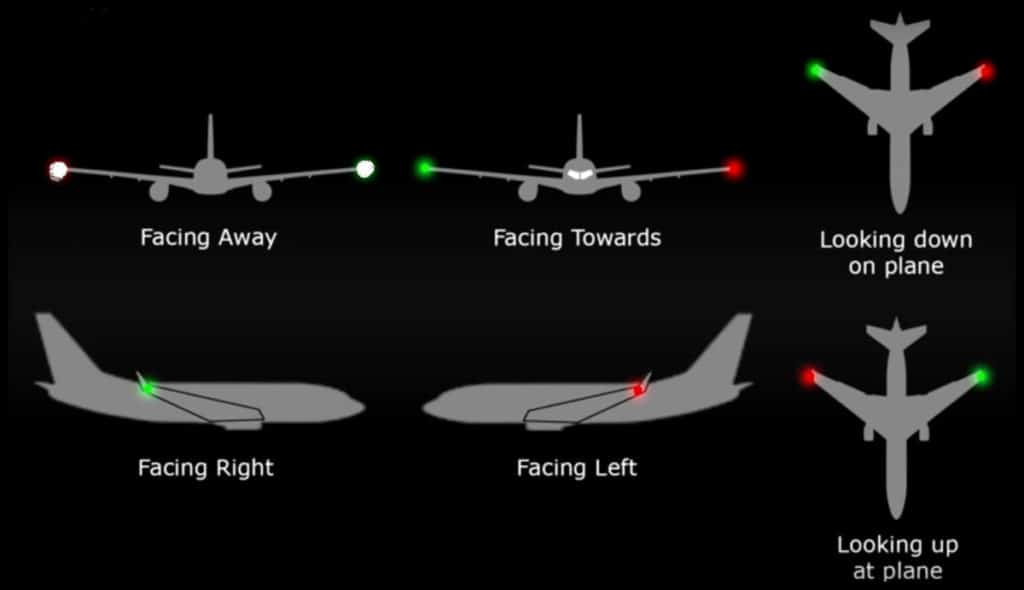
Just like all aircraft, helicopters have the same light colors mounted on them to ensure pilots of other aircraft can identify the helicopter and see which direction it is flying in relation to them.
For helicopter pilots, having a powerful and moveable searchlight is a godsend in very poorly lit areas. When I used to fly EMS without the use of night-vision goggles, the pilot-controlled searchlight became very useful when searching for the remote community helipads and ensuring they were clear of obstacles when completing the prelanding recce.
If the helicopter is really geared up for night operations, they can have multiple search and landing lights fitted, and nowadays pretty much every commercial operator will also equip the helicopter and pilot/s with night-vision goggles.
How Do Pilots Fly Safely at Night?
To safely fly at night pilots need regular training and remain clear of obstacles and other aircraft especially when landing and taking off. If no visual illumination is available pilots must follow set rules and surveyed routes to ensure obstacle clearance at all times.
No matter what aircraft a pilot is flying there are three main ways that pilots will fly to ensure they can remain safe at night:
- Visual flight over well-lit, populated areas
- Visual flight using night vision goggles
- Instrument flight using Routes & MOCA’s
1. Visual Flight Over Well Lit, Populated Areas
For the majority of helicopters you see flying over your house at night this is the kind of flying the pilot will be doing.
To fly a helicopter safely, the pilot must be able to see some form of horizon to ensure they keep the helicopter upright. The lights of a city provide that reference to the pilot so it makes it easy to control the helicopter. The most basic helicopters can be easily flown over a well-lit city at night.
If you have ever been to Las Vegas you may have seen or even been on a helicopter tour of the ‘Strip’ and you will know exactly what I’m talking about.
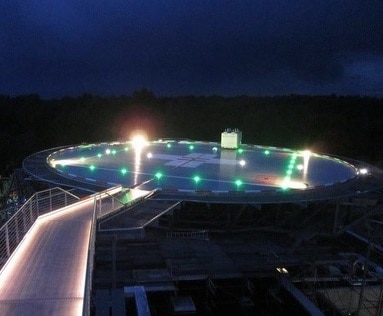
To help pilots find helipads and airports within the city lights those facilities will have rotating or flashing beacons and lights that are usually a different color to the surrounding area. Green lights surrounding a hospital helipad are a common example.
When city lights are sparse, non-existent or the helicopter will be flying over large bodies of water, then things become more complicated.
2. Visual Flight Using Night-Vision Goggles
When helicopters need to fly into remote and dark parts of the region pilots lose their visual cues of where the horizon is and this becomes a problem as the pilot will not know which way is up. On moonless nights it can become impossible to see what is ground and what is sky.
To help pilots who fly and land in territory like this, most police, ambulance, and all military helicopters will be equipped with night–vision goggles (NVG’s). These goggles are fitted to the pilot’s helmet and take in the smallest amount of terrestrial light and amplify them onto screens within each eyepiece, effectively turning night into day.
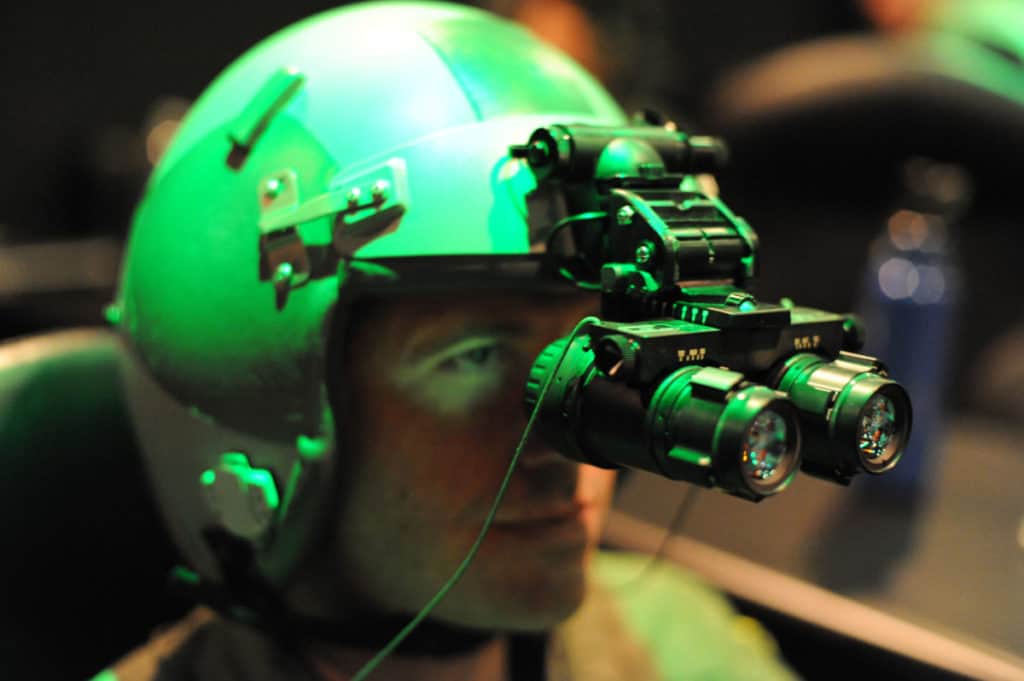
These goggles allow the pilots to once again see the horizon and the ground around them allowing them to land, cruise, and take off in the darkest areas, with training of course.
Having flown in very dark regions for years without NVG’s, I can tell you that they are a game changer when it comes to seeing at night, although the added weight of the goggles on the helmet can really make the neck and shoulders ache after a long flight in a vibrating helicopter!
3. Instrument Flight Using Routes and MOCA’s
When flying at night the pilot’s biggest enemy is unseen obstacles. Rising terrain, towers, wind turbines, and cable spans cause many accidents every year the world over. To help protect pilots, many helicopter operators will prepare surveyed routes for their most popular flying legs. These routes will usually be a direct line from point A to point B and will be surveyed for all obstacles along and out to the sides up to 3-10 nautical miles.
During the survey, the surveyor will look for any obstacles along that corridor and chart them as well as noting the highest obstacle along the route.
For example, if there is a tower within that corridor that rises 300ft above the ground, the surveyor will then set the lowest height the helicopter can fly over that route to be 500-1000ft higher, eg:
The helicopter must fly no lower than:
300ft tower + 500ft clearance = Route altitude at least 800ft above the ground
or
300ft tower + 1,000ft clearance = Route altitude at least 1,300ft above the ground
Each company will have its own clearance altitude limitations and these are known as a MOCA – Minimum Enroute Clearance Altitude.
If the pilot flies no lower than this height they will not hit any obstacle along that route.
For pilots that don’t fly common routes, or are heading off the route, they can look at their aviation chart and find the highest obstacle in that area and apply their company clearance limits to that.
This way, when flying in that area and while en route they can be assured they will have sufficient clearance. When coming into land the pilot/s will either need to be landing at a certified heliport or airport that has published instrument approach and clearance procedures or by using night-vision goggles to ensure they see any obstacles during their approach to land.
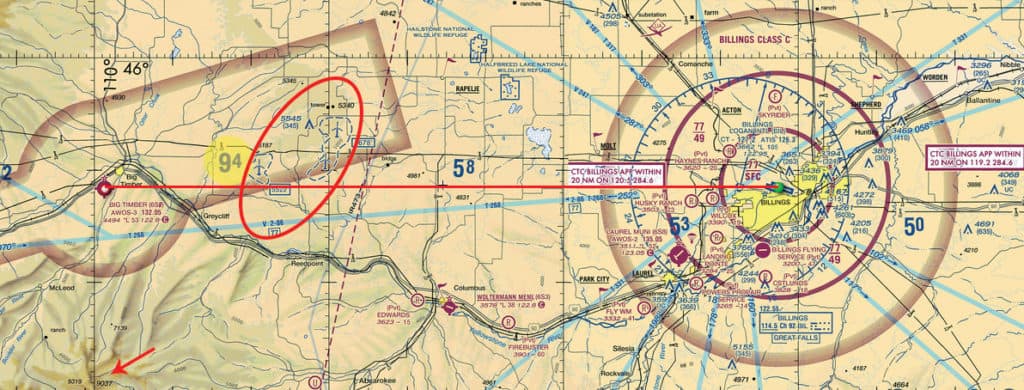
Take this chart for example:
A pilot flying west from Billings Airport to Big Timber Airport will see that there are wind turbines to the north of their route and high terrain to the southwest of their route. The ‘94‘ highlighted in yellow tells the pilot the highest obstacle in that sector is 9,400 feet above sea level minus 300 feet (rounded to the nearest 100ft) for clearance.
By looking at the chart you can see rising terrain at the arrow with the highest peak being 9,034 feet above sea level.
Flying at 9,600ft (9,035ft rounded up to the nearest 100ft (9,100ft) + company 500ft clearance altitude) will ensure the helicopter will be clear of any obstacles along that route.
Now, so long as the cloud layer is above that the pilot will be fine on that flight. Poor weather is one of the biggest factors in helicopter accidents at night.

